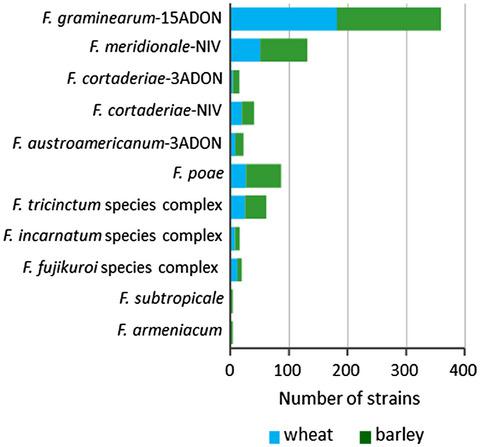当前位置:
X-MOL 学术
›
Plant Pathol.
›
论文详情
Our official English website, www.x-mol.net, welcomes your
feedback! (Note: you will need to create a separate account there.)
Five‐year survey uncovers extensive diversity and temporal fluctuations among fusarium head blight pathogens of wheat and barley in Brazil
Plant Pathology ( IF 2.3 ) Pub Date : 2020-10-08 , DOI: 10.1111/ppa.13289 Carolina B. Pereira 1 , Todd J. Ward 2 , Emerson M. Del Ponte 3 , Gláucia Mara Moreira 3 , Mark Busman 2 , Susan P. McCormick 2 , Heraldo R. Feksa 1, 4 , Juliano L. De Almeida 4 , Dauri J. Tessmann 1
Plant Pathology ( IF 2.3 ) Pub Date : 2020-10-08 , DOI: 10.1111/ppa.13289 Carolina B. Pereira 1 , Todd J. Ward 2 , Emerson M. Del Ponte 3 , Gláucia Mara Moreira 3 , Mark Busman 2 , Susan P. McCormick 2 , Heraldo R. Feksa 1, 4 , Juliano L. De Almeida 4 , Dauri J. Tessmann 1
Affiliation

|
We conducted a five‐year survey (2011–2015) of barley and wheat fields in Paraná state, Brazil, obtaining 754 Fusarium isolates from spikes with fusarium head blight (FHB)‐symptoms. Multilocus genotyping and TEF‐1α gene sequence analyses confirmed the dominance of the F. graminearum species complex (FGSC, 75.7%), but F. poae (11.5%), as well as F. avenaceum and related members of the F. tricinctum species complex (FTSC, 8.1%) appeared as substantial contributors to FHB. Within the FGSC, F. graminearum of the 15‐ADON genotype was dominant (63%), followed by F. meridionale of the NIV genotype (23.1%), F. cortaderiae of the NIV (7%) or 3‐ADON (2.6%) genotypes, and F. austroamericanum (3.8%) of the 3‐ADON genotype. Substantial variation in pathogen composition was observed across years, with F. poae and F. meridionale frequencies significantly elevated in some years. Most F. poae strains produced DAS, diANIV, and butenolide, but not neosolaniol, T‐2, or HT‐2. All FTSC species produced moniliformin. Enniatin production was widespread among FTSC species, with the single F. acuminatum strain found to be the strongest producer of enniatins. Our findings confirm FGSC as a major contributor to FHB and expand considerably our knowledge of the presence, frequency, and conditions under which other pathogens may emerge, altering the spectrum of toxins that may accumulate in grain.
中文翻译:

五年调查揭示了巴西小麦和大麦的镰刀菌枯萎病病原体之间广泛的多样性和时间波动
我们在巴拉那州,巴西进行了为期五年的大麦和小麦田的调查(2011- 2015年),获得754镰刀从赤霉病穗株(FHB)-symptoms。多基因座基因分型和TEF- 1α基因序列分析证实了F的优势。菌物种复杂(FGSC,75.7%),但˚F。poae(11.5%),以及˚F。avenaceum和相关成员˚F。tricinctum物种复合物(FTSC,8.1%)似乎是促成FHB的主要因素。在FGSC中,F。禾本科的15-ADON基因型为显性(63%),其次是˚F。NIV基因型子午线(23.1%),F。cortaderiae的NIV(7%)或3- ADON(2.6%)的基因型,和˚F。3‐ADON基因型的奥氏体(3.8%)。跨越年观察到在组合物中的病原体实质变化,与˚F。poae和˚F。子午线频率在几年中显着升高。大多数˚F。诗菌株产生DAS,diANIV和丁烯内酯,但未产生新草胺醇,T-2或HT-2。所有FTSC物种都产生莫尼莫丁。恩镰孢菌素的产量为FTSC物种之间广泛,跟单˚F。尖锐湿疣应变发现是恩镰孢素的最强的生产商。我们的发现证实FGSC是FHB的主要贡献者,并大大扩展了我们对其他病原体可能出现的存在,频率和条件的了解,从而改变了谷物中积累的毒素谱。
更新日期:2020-10-08
中文翻译:

五年调查揭示了巴西小麦和大麦的镰刀菌枯萎病病原体之间广泛的多样性和时间波动
我们在巴拉那州,巴西进行了为期五年的大麦和小麦田的调查(2011- 2015年),获得754镰刀从赤霉病穗株(FHB)-symptoms。多基因座基因分型和TEF- 1α基因序列分析证实了F的优势。菌物种复杂(FGSC,75.7%),但˚F。poae(11.5%),以及˚F。avenaceum和相关成员˚F。tricinctum物种复合物(FTSC,8.1%)似乎是促成FHB的主要因素。在FGSC中,F。禾本科的15-ADON基因型为显性(63%),其次是˚F。NIV基因型子午线(23.1%),F。cortaderiae的NIV(7%)或3- ADON(2.6%)的基因型,和˚F。3‐ADON基因型的奥氏体(3.8%)。跨越年观察到在组合物中的病原体实质变化,与˚F。poae和˚F。子午线频率在几年中显着升高。大多数˚F。诗菌株产生DAS,diANIV和丁烯内酯,但未产生新草胺醇,T-2或HT-2。所有FTSC物种都产生莫尼莫丁。恩镰孢菌素的产量为FTSC物种之间广泛,跟单˚F。尖锐湿疣应变发现是恩镰孢素的最强的生产商。我们的发现证实FGSC是FHB的主要贡献者,并大大扩展了我们对其他病原体可能出现的存在,频率和条件的了解,从而改变了谷物中积累的毒素谱。











































 京公网安备 11010802027423号
京公网安备 11010802027423号